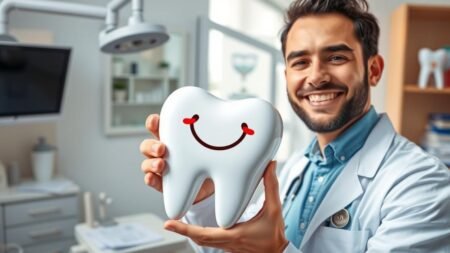Ever wondered if brushing too soon after using whitening strips ruins your teeth whitening? This is a big question for many asking, do I brush my teeth after whitening strips? The answer might just change how you care for your teeth.
Whitening strips are a hit for a brighter smile at home. They’re thin, flexible, and coated with whitening gel. But, their success depends on what you do after using them.
Crest, a top oral care brand, says you don’t need to brush right after using their 3D Whitestrips. This might seem odd, but there’s science backing it up.
Dentists suggest waiting 30 minutes before brushing after using whitening strips. This lets your enamel recover and avoids sensitivity. Instead, rinse with water to get rid of any leftover gel.
Knowing how to use whitening strips right is key for best results and oral health. Keep reading to learn the best ways to use whitening strips and take care of your teeth before and after.
Teeth Whitening Strips and Their Effects
Tooth whitening strips are a favorite for bleaching teeth at home. They are thin, flexible, and coated with a gel. This gel helps remove stains from your teeth.
How Whitening Strips Work on Tooth Enamel
Whitening strips use special ingredients to get into your tooth enamel. The gel breaks down into oxygen molecules. These molecules then work with stains in your teeth to whiten them.
Active Ingredients in Whitening Products
The main ingredients in these strips are hydrogen peroxide or carbamide peroxide. These chemicals do the bleaching. The amount in each product can change how well they work.
Duration and Effectiveness of Treatment
Using whitening strips usually takes 7 to 14 days. You need to apply them every day. The time you wear them can vary from 30 minutes to over an hour. The results can last 6 to 12 months, depending on how well you take care of your teeth.
Whitening strips are usually safe for your enamel if used right. But using them too much can cause sensitivity and gum problems. Always follow the directions to keep your teeth and gums safe and get the best results.
Do I Brush My Teeth After Whitening Strips
Whitening strips are a hit for at-home teeth whitening, with over 40 million Americans using them in 2020. It’s key to know how to care for your teeth after using these strips. This ensures the best results and avoids side effects.
Waiting Period After Strip Removal
Don’t brush your teeth right after using whitening strips. Dental experts say wait 30 minutes first. This lets your enamel harden again, which helps prevent sensitivity. You can rinse with water to get rid of any leftover strip residue during this time.
Proper Removal of Whitening Residue
Getting rid of whitening strip residue is important. Carefully remove the strips and rinse your mouth with lukewarm water. This removes any leftover product without hurting your gums or teeth.
Safe Brushing Techniques Post-Treatment
When you’re ready to brush, use a soft-bristled toothbrush and non-abrasive toothpaste. Brush gently to avoid hurting sensitive teeth and gums. About 45% of users feel tooth sensitivity after using strips, so be gentle.
| Post-Treatment Care | Recommendation |
|---|---|
| Waiting Period | 30 minutes minimum |
| Residue Removal | Rinse with lukewarm water |
| Brushing Technique | Soft-bristled brush, gentle pressure |
| Toothpaste | Non-abrasive formula |
Whitening strips can remove surface stains well. But, taking good care of your teeth after using them is vital. It keeps your smile bright and protects your oral health.
Best Practices for Pre and Post Whitening Care
Proper teeth whitening care is key to a brighter smile. Before using whitening strips, brush and floss your teeth. This removes plaque and food, helping the gel work better.
While whitening, keep your teeth clean. Use a soft toothbrush to avoid irritation. Drink water to rinse away gel and keep your mouth fresh.
After whitening, avoid staining foods and drinks for an hour. This means no coffee, red wine, tea, or fruit juice. Keep your teeth white by brushing twice a day and flossing once. Use a whitening toothpaste too.
See your dentist every six months for cleanings. They remove stains and tartar, keeping your teeth white. Your dentist can also check on your oral health and whitening concerns.
- Wait 30 minutes after brushing before applying whitening strips
- Use whitening strips as directed, typically for 30 minutes once or twice daily
- Continue the treatment for the recommended period, usually 14 days
- Be mindful of tooth sensitivity and gum irritation during the process
Follow these tips to get the most from your teeth whitening. And keep your teeth and mouth healthy.

Managing Sensitivity and Avoiding Common Mistakes
Teeth whitening can sometimes cause discomfort. It’s important to know how to handle tooth sensitivity after whitening. Also, preventing gum irritation from whitening strips is key for a good experience. Let’s look at safe whitening practices to keep your smile bright and healthy.
Signs of Tooth Sensitivity
Tooth sensitivity after whitening feels like sharp, temporary pain. This pain happens when brushing, eating, or drinking. It’s common with over-the-counter whitening kits.
Higher concentrations of bleaching agents like carbamide and hydrogen peroxide cause more sensitivity.
Preventing Gum Irritation
Gum irritation from whitening strips can happen if not applied right. To avoid it, don’t overlap strips onto your gums. For at-home treatments using gel trays, make sure they fit right to prevent gum irritation.
Professional treatments often include ingredients like fluoride and potassium nitrate to fight sensitivity.
Safe Product Usage Guidelines
Follow these safe whitening practices to minimize discomfort:
- Use a soft-bristled toothbrush to prevent further damage
- Apply desensitizing toothpaste before, during, and after treatment
- Consider taking a nonsteroidal anti-inflammatory drug before whitening
- Avoid cold beverages or use a straw to drink them
- If sensitivity persists, consult your dentist about lowering peroxide concentration
Remember, safe whitening practices are key to achieving a brighter smile without harming your oral health. Always follow product instructions and consult a dental professional if you experience persistent sensitivity or irritation.
Conclusion
Proper oral care after whitening is key to keeping your smile bright. Wait at least 30 minutes before brushing after using whitening strips. This lets your enamel recover and reduces sensitivity.
When brushing, use gentle techniques to protect your teeth. For the best teeth whitening tips, always follow product instructions. If you feel sensitivity, skip a day between treatments.
Using toothpaste for sensitive teeth can also help. To keep your teeth white, practice good oral hygiene. Limit foods and drinks that stain your teeth.
Professional options like Crest 3D Whitestrips Professional Effects ($45 on sale) or in-office treatments work faster. For a gradual approach, try whitening mouthwashes with low peroxide. Custom trays from dentists offer controlled whitening with professional-grade gel.
By following these tips and consulting your dentist, you’ll get a brighter smile. Remember, consistent care is essential for long-lasting whitening results.
FAQ
How long should I wait to brush my teeth after using whitening strips?
Wait at least 30 minutes after taking off whitening strips before brushing. This lets your enamel harden again. It helps prevent sensitivity.
Can I rinse my mouth immediately after removing whitening strips?
Yes, rinse with water right after taking off the strips. It removes the gel without needing to brush right away.
How do whitening strips work on tooth enamel?
Whitening strips have hydrogen peroxide or carbamide peroxide. These break down into oxygen. The oxygen changes discolored molecules in your teeth, making them whiter.
How long does the whitening effect from strips last?
Whitening effects can last 6-12 months. Good oral care and avoiding staining foods can help keep it going longer.
Are whitening strips safe for tooth enamel?
Whitening strips are safe for enamel if used right. But, using them too much or wrong can damage enamel and cause sensitivity. Always follow the instructions.
How can I prevent tooth sensitivity during whitening treatments?
Use sensitive teeth toothpaste before and during treatment. Also, don’t put the strips on your gums and don’t use them for too long.
What should I do if I experience persistent tooth sensitivity after using whitening strips?
If sensitivity lasts, use them less or talk to your dentist. They might suggest other ways to whiten your teeth.
How can I maintain my whitening results?
Keep your teeth white by brushing twice a day and flossing. Use whitening toothpaste and limit staining foods. Also, see your dentist regularly.
Should I brush my teeth before applying whitening strips?
Yes, brush and floss gently before using strips. It removes plaque and food, helping the gel work better.
How often should I use whitening strips?
Use them as the product says, usually 7-14 days. Don’t use them too much to avoid enamel damage and sensitivity.








